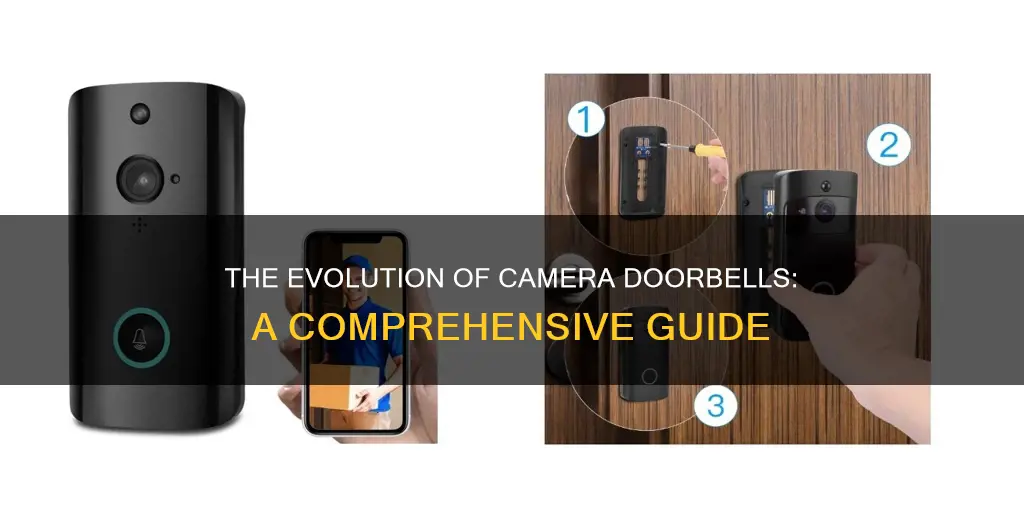
A doorbell camera, also known as a video doorbell, is an essential component of a smart home system. It is a doorbell that has been enhanced with a motion detector, a built-in video camera, and a speaker. When someone approaches the door, the motion detector is triggered, and the smart doorbell starts recording. The user receives a notification and can view a live video feed of the person outside the door through their smartphone or smart hub. The two-way audio feature allows users to communicate with visitors remotely. Video doorbells can be wired or wireless, with the latter being easier to install but requiring periodic battery changes. They also vary in terms of video quality, storage options, smart-home integrations, and artificial intelligence capabilities. Some popular video doorbell brands include Ring, Google Nest, Arlo, Blink, and Eufy.
| Characteristics | Values |
|---|---|
| Purpose | To see and speak with visitors at the door, even when you are not home |
| Power Sources | Wired, wireless (battery-powered), solar-powered |
| Two-Way Audio | Yes |
| Motion Detection | Yes |
| Night Vision | Yes |
| Smart Home Integration | Yes |
| Subscription | Optional |
What You'll Learn
- Camera doorbell power sources: wired, wireless, or solar-powered
- Camera doorbell motion detection: how it works and its benefits
- Camera doorbell installation: wired vs wireless
- Camera doorbell costs: equipment, storage, and monitoring
- Camera doorbell benefits: convenience, security, and package theft prevention

Camera doorbell power sources: wired, wireless, or solar-powered
Camera doorbells can be wired, wireless, or solar-powered, each with its own advantages and disadvantages.
Wired doorbells are connected to the existing doorbell wiring and chime box, providing continuous power and eliminating the need for recharging batteries. They are generally cheaper, more compact, and work better than wireless options. However, the installation process is more complex and may require an electrician. Examples of wired camera doorbells include the Google Nest Doorbell and the Ring Wired Doorbell Pro.
Wireless doorbells, on the other hand, are powered by rechargeable batteries, making them easy to install and allowing for flexible placement. They are larger in size and require regular battery recharging or replacement. The Ring Video Doorbell and the Blink Video Doorbell are popular wireless options.
Solar-powered doorbells harness sunlight to generate electrical energy, which is stored in a battery to power the device. They are environmentally friendly, cost-effective, and easy to install. However, they may not work effectively in areas with limited sunlight. The Ring Video Doorbell with Solar Panel and the Ecoey GW1002 Video Doorbell are examples of solar-powered camera doorbells.
When choosing a power source for a camera doorbell, consider factors such as ease of installation, reliability, cost, and the amount of sunlight available. Wired doorbells offer better performance but require more complex installation, while wireless options provide flexibility and convenience but need frequent battery changes. Solar-powered doorbells are a sustainable and cost-effective choice but may not be suitable for areas with insufficient sunlight.
Mastering Camera Raw: Saving Adjustments Like a Pro
You may want to see also

Camera doorbell motion detection: how it works and its benefits
Camera doorbell motion detection is a valuable feature that enhances the functionality of your smart doorbell. Here's how it works and why it's beneficial:
How It Works
Camera doorbells use motion sensors to detect movement within a specified zone. When motion is detected, the security camera activates a live stream, allowing you to see what's happening in real time. Some camera doorbells also have artificial intelligence capabilities that can distinguish between people and other objects, reducing the number of unnecessary notifications.
The motion detection feature ensures that you're alerted only when there's relevant activity at your doorstep. You can also adjust the sensitivity of the motion sensors to customize the detection zone and minimize false alerts.
Benefits of Motion Detection
Enhanced Security:
Motion detection acts as an effective deterrent against burglars and intruders. It not only detects their presence but also records them on video, providing valuable evidence in case of a break-in.
Package Monitoring:
With motion detection, you can keep an eye on deliveries and packages. You'll receive a notification when someone is at your door, even before they ring the bell, giving you extra time to attend to the delivery.
Convenience:
Motion detection, coupled with two-way audio, allows you to communicate with guests and delivery persons without having to physically answer the door. This is especially useful when you're busy or away from home.
Integration with Smart Locks:
By pairing your motion sensor doorbell with a smart lock, you can remotely unlock the door for guests or delivery persons, adding convenience and security.
Peace of Mind:
Motion detection helps you monitor your doorstep even when you're not at home, giving you peace of mind that your home is secure.
By combining motion detection with other features like two-way audio, cloud storage, and smart home integrations, camera doorbells offer a comprehensive solution for home security and convenience.
Charging the FinePix XP120: A Step-by-Step Guide
You may want to see also

Camera doorbell installation: wired vs wireless
Camera doorbells are either wired or wireless, and both options have their pros and cons.
Wired doorbells are powered by a direct electrical connection, while wireless doorbells are battery-operated.
Wired Doorbells
Wired doorbells are more reliable than wireless doorbells because they have a continuous power supply. They also tend to have a longer lifespan and are more secure, as there is no risk of the battery being removed or the doorbell losing power. Wired doorbells also offer advanced features without worrying about battery life.
However, wired doorbells can be more complicated to install, especially if you don't have any experience with wiring and drilling. They may also require an upgraded transformer to work with a newer or video doorbell. Older homes, in particular, may need an upgraded transformer. Wired doorbells are also less portable and less flexible in terms of placement.
Wireless Doorbells
Wireless doorbells are often easier to install than wired doorbells, as they don't require any wiring. They are also more portable and can be repositioned without constraints. Wireless doorbells are powered by batteries, which need to be replaced or recharged periodically.
However, wireless doorbells may be more expensive than wired doorbells, and their designs are often simplistic and limited. They also require a working internet connection to view live footage, and there is a chance of radio interference.
Both wired and wireless camera doorbells have their advantages and disadvantages. Wired doorbells offer a more reliable and secure connection, while wireless doorbells are more convenient and flexible. Ultimately, the decision between a wired or wireless camera doorbell depends on your specific needs and preferences.
Kodak Camera Battery Drain: Why It Happens and How to Fix It
You may want to see also

Camera doorbell costs: equipment, storage, and monitoring
The cost of a camera doorbell varies depending on the brand and features included. The equipment cost for a camera doorbell ranges from $59.99 to $349.99. The average cost of a video doorbell is around $172.
In addition to the equipment cost, there may also be monthly or yearly costs associated with storage and monitoring. Storing doorbell camera footage can be done on a local microSD card or a cloud server, which may be free or come with a subscription fee. Typically, this cost does not exceed a few dollars per month.
Monitoring services for camera doorbells are usually optional and range from $3 to $20 per month. These services provide additional security by alerting a monitoring centre of any motion or people detected, who can then verify if help is needed and contact the police if necessary.
Overall, the cost of a camera doorbell, including equipment, storage, and monitoring, can range from a few dollars per month to a few hundred dollars for the equipment, plus the cost of any subscription services.
Camera Battery Maintenance: How Often to Replace?
You may want to see also

Camera doorbell benefits: convenience, security, and package theft prevention
Convenience
Video doorbells offer a range of features that make life more convenient. For example, they can be used to:
- Answer the door from anywhere in the world through a mobile application, allowing you to greet guests remotely.
- Check who is at the door via an app or smart display, so you don't have to rush to the door every time the bell rings.
- Communicate with delivery drivers and give instructions on where to leave packages.
- Monitor children when they are home alone or with a babysitter.
Security
Video doorbells can also enhance security by:
- Deterring opportunistic thieves. A visible camera on the doorbell makes would-be burglars think twice, knowing they have been caught on video.
- Providing video evidence in case of a burglary, which can help the police catch the offender and recover your belongings.
- Monitoring vacant properties while you're away.
- Notifying you when someone approaches your door, even if they don't ring the bell, so you can keep an eye on your front door at all times.
Package Theft Prevention
In addition to enhancing security, video doorbells can help prevent package theft by:
- Alerting you when a package is delivered, so you can bring it inside right away.
- Allowing you to communicate with the delivery driver and give instructions on where to leave the package if you're not home.
- Providing video evidence in case a package is stolen, which can help identify the package thief and get your package returned.
Unleash Photography with Camera Raw CC
You may want to see also
Frequently asked questions
Camera doorbells have motion detectors, built-in video cameras, and speakers. They connect to your smartphone through an app, allowing you to receive alerts when someone is at your door, talk to people outside your home, and watch what's happening in real time or as recorded footage.
Camera doorbells are Wi-Fi-enabled devices that connect to your home's existing doorbell system and Wi-Fi connection. When the doorbell is pressed, a chime goes off, and the motion detector is triggered, alerting you to the presence of a visitor. You can then open the doorbell camera app on your phone and see a live video feed of the person outside your door.
Camera doorbells can be wireless or hardwired. Wireless camera doorbells are typically easier to install, as they often use peel-and-stick adhesives and don't require dealing with any electrical wiring. Hardwired camera doorbells, on the other hand, connect to your home's existing doorbell and chime setup, which may be more complicated and require some electrical work.
Camera doorbells offer both security and convenience. They allow you to screen visitors, answer the door remotely, and monitor package deliveries. They can also help prevent burglaries and provide a sense of safety, especially when combined with smart locks and other smart home devices.







